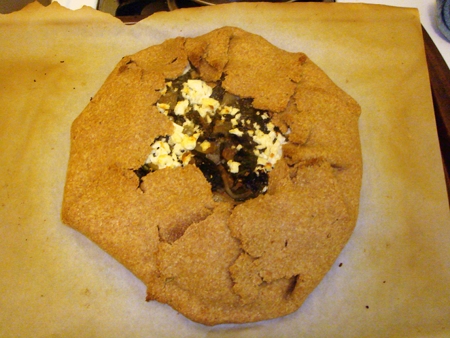Pie=pi, theory - math, get it? Gosh, I crack myself up.
No really, when it comes to baking, the theory of pie is pretty simple - make a crust, put something in it, cover it, or not, and bake (or not if you are looking at icebox pies filled with like pudding, or fresh fruit, but that's kind of a tangent - tangent, more math, man I'm good!)
The thing is, not all pies are created equal and what sounds good in theory can miss the mark in execution. Like this spinach and feta pie I made.

See, I told you I was on a pie kick.
The spinach and feta pie was something I had bumping around my brain since thinking up applications for the whole wheat and olive oil pie dough I made for the surprise birthday pie. Then there was a Swiss chard pie with olive oil pie dough in Everday Food (curse you Martha). Then I knew what I had to do. I took her basic recipe for the filling, added the Chocolate and Zucchini recipe for the dough (using the original recipe and not the sweet variation) added a little feta and wham! instant pie.
Well, it was pie. But it really wasn't ...mmm... pie... Here are some things that I think could be improved:
The Crust:
1) Use some all purpose flour, I think the texture came out a little too grainy. It wasn't noticable in a traditional usage, but when the folds double up in this galette style pie, it really becomes a prominent textural feature.
2) Roll the crust thinner. See the reasoning behind number 1.
3) Use less salt and better olive oil. The amount of salt called for in the recipe seemed to be a bit too much in practice, and my olive oil could have been fresher. When olive oil is one of the main flavor profiles of a recipe, it should probably be pretty decent olive oil.
The Filling:
1) Cook ingredients separately, and don't cook the lemon juice. The EDF filling recipe called for cooking the greens, pepper flakes, onions and garlic, taking off the heat, and THEN mixing in the lemon and Parmesan cheese but I didn't read the directions carefully enough or thought I could take a shortcut and the result was too acidic without really being recognizably lemony. I also added mushrooms. The combination of flavors just became muddy and nothing stood out, they all just tasted green and sharp. Valuable lesson: follow directions.
2) More garlic. When is this not a good idea?
3) More pepper flakes. See number 2.
4) Use full fat feta. I don't know what on earth possessed me to purchase low-fat feta. It is grainy and unpleasant. It doesn't fare well when baked either. Next time I will just suck it up and use the full-fat version. Its not that bad for you and it tastes SO much better.
5) I may play around with adding a bit of sweetener. The acid really needed a counterpoint. Maybe caramelizing the onions a bit more, or making them with balsamic vinegar and omitting the lemon would work. This fix is to be determined.
Baking:
1) Bake longer. I got gun shy and bits of my crust were a bit soft still. Wait till the whole thing is golden brown (which I have to say is hard to do when your dough is pretty brown to begin with.
2) Use a wash. This is really just for aesthetic reasons. The plain crust was really just a little sad. It would have benefited from a little shine.
There you go, not a perfect winner, but perfectly edible (I did end up eating the whole thing over the next two days) and a learning experience to boot. I think this one can be worked out, but we'll save the recipe till later then.
Wednesday, April 21, 2010
The Theory of Pie
Subscribe to:
Post Comments (Atom)



No comments:
Post a Comment